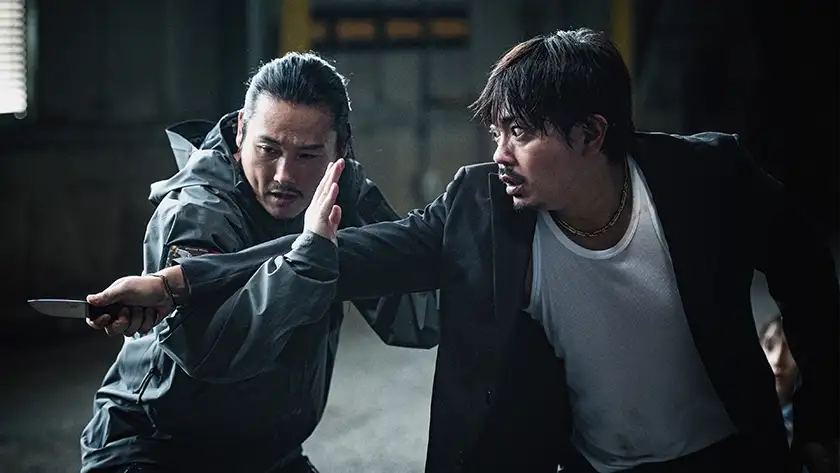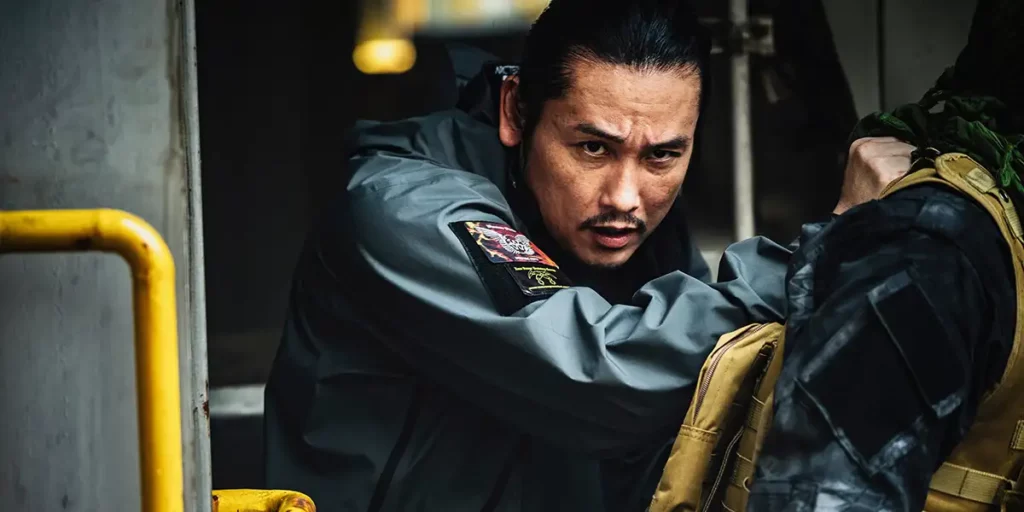In meta action film One Percent Warrior, choreographed by the legendary Kensuke Sonomura, Tak Sakaguchi is an action star making a movie that lets him test skills for real.
Tak Sakaguchi, as Toshiro, the action star, is a bit of a Tom Cruise character in the best way in One Percent Warrior. Instead of jumping off cliffs on motorcycles for the best and most authentic stunts for the newest Mission Impossible, our fictional action star has spent his life training and perfecting his mastery of the deadly arts. The character is driven by his desire to make a real action film.
Toshiro is method to the extreme, and instead of Superman being faster than a speeding bullet, our lead character is so skilled he’s faster than the pull of a trigger finger. But it’s for naught, as the character laments in the opening faux-documentary interviews about his work, because it’s not real, and it’s all choreographed. This is the quest of One Percent Warrior, and we’re taken on quite an unexpected journey with Toshiro as the movie progresses.
As a constant throughline for the story, the authentic film is Toshiro’s motivator. There’s a dust-up between the star and the world-renowned director of his latest project, and he’s had enough of it. The actor, urged on by his assistant Akira, decides to make his own guerilla-style, real action film. He’s not there to do good or save the world; he just wants to fight and prevail for real on film. It is the ultimate LARP or test of the skills he has perfected over years of training for the big screen. But he’s dodging real bullets.. or wrenches, in this case.
There are moments of the One Percent Warrior that will unlock a deeper trauma if you’re a filmmaker. Akira, the apprentice’s great search for locations that ultimately ends up on a mysterious industrial island, is a The Devil Wears Prada-sized assistant task. If you’ve ever tried to make a film, the painful quest for a location won’t seem unfamiliar. Finding this “abandoned” island and the shady gatekeeper sets off a chain of events where something happens for real with deadly consequences. It looks like the in-film movie makers aren’t the only ones who saw the appeal of a deserted island with no cell reception. Gangsters are using the factory’s bowels as a base for their activities, and the actor and the apprentice, it turns out, will have the chance to make their real authentic action film after all.
Is this a comedy? We are led to believe it at first. But it slips from the absurd to something darker and more thrilling as time passes, and the camera keeps rolling. The first third of the film takes you down the comedic path, but quite abruptly, it changes. The movie loses some of its breezy style with the turn to seriousness, and the audience is perhaps not quite adequately prepared for the bloody violence that is about to ensue. There is a clear before and after, and they are tonally distinct. The meta commentary is the linking factor, threading through the needle for both worlds and keeping us anchored to Toshiro.
When the real action starts, and we think it crosses from fiction to truth, One Percent Warrior’s tone shifts from Hollywood (or in this case, Japan) sized star actor indulgence à la Prime Video’s JCVD, The Unbearable Weight of Massive Talent, or even strangely enough America’s Sweethearts to something more satisfyingly sinister. The music amps this up, too, twangy rock coming into play, cueing us that we’re in a whole new world.

As the real actor, Tak Sakaguchi brings a sense of control to the narrative. Even though his character is supposed to be out of his element, he’s never a fish out of water. His actions are methodical, and the character was born for this. Sakaguchi’s precision, honed in films like Versus and Reborn, is in full display with One Percent Warrior.
The frame where the actor realizes he will have his chance to be a “real” action star is quite memorable, for within that shot is conveyed the satisfying realization of unrealized dreams finally coming to pass. If there was a meme of “this is my moment,” the film frame of tonal shift where the Toshiro is framed by light in an almost religious motif would be it.
Outside of the Meta commentary and occasional Streetcar Stella-like cries of “Jackie!” (Sorry Jackie Chan), the camera work in this film is quite impressive. An exterior sequence of drone shots that weaves in and out of the pipes at the zinc factory makes you feel like you’re watching Star Wars and the trench run or even Tom Cruise leading the way for fighters through treacherous rocky canyons in Top Gun: Maverick.
Regarding the action and the fights, it is quite well done when it gets going. Kensuke Sonomura is a master of action choreography. One Percent Warrior’s action feels natural, fluid, and novel. It’s not highly slick and stylized like John Wick, but it is brutal and kinetic, save for one sequence that is perhaps intentionally most ballet-like and full of more meta-commentary. I’ll leave you to ponder, “If you give an action star a flashlight, you never know what you’re going to get.” Yes, Virginia, you know what you’re going to get.
There’s a moment early in the movie, before the tone shifts, where Toshiro is amping up his apprentice, who is ready to quit. Toshiro says only one percent of martial arts students are able to master their craft and become great. Perhaps that’s a fair metaphor for filmmaking. While there is something to be gained from engaging with art outside of your typical comfort zone, and even “bad” films have value, sometimes movies or moments in movies connect with us on a cellular level.
One Percent Warrior’s ending is quite sad and will leave an assistant-sized hole in your heart, but not for the reasons you expect. Out of a hundred films, perhaps only one percent manages to rise and be worthy of re-watching. Director and writer Yûdai Yamaguchi’s One Percent Warrior fits that bill, and you’ll want to go back and see it again to look for clues once you know how it ends.
One Percent Warrior was released on Blu-ray & Digital on March 12, 2024.
Loud and Clear Reviews has an affiliate partnership with Apple, so we receive a share of the revenue from your purchase or streaming of the films when you click on the button on this page. This won’t affect how much you pay for them and helps us keep the site free for everyone.

